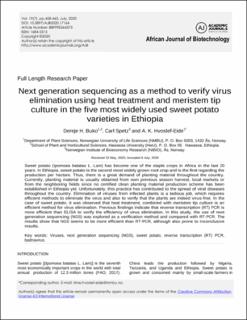| dc.contributor.author | Buko, Dereje Haile | |
| dc.contributor.author | Spetz, Carl | |
| dc.contributor.author | Hvoslef-Eide, Anne Kathrine | |
| dc.date.accessioned | 2021-02-09T09:51:44Z | |
| dc.date.available | 2021-02-09T09:51:44Z | |
| dc.date.created | 2020-09-24T15:15:33Z | |
| dc.date.issued | 2020-07-31 | |
| dc.identifier.citation | African Journal of Biotechnology. 2020, 19 (7), 458-463. | en_US |
| dc.identifier.issn | 1684-5315 | |
| dc.identifier.uri | https://hdl.handle.net/11250/2726815 | |
| dc.description.abstract | Sweet potato (Ipomoea batatas L. Lam) has become one of the staple crops in Africa in the last 20 years. In Ethiopia, sweet potato is the second most widely grown root crop and is the first regarding the production per hectare. Thus, there is a great demand of planting material throughout the country. Currently, planting material is usually obtained from own previous season harvest, local markets or from the neighboring fields since no certified clean planting material production scheme has been established in Ethiopia yet. Unfortunately, this practice has contributed to the spread of viral diseases throughout the country. Elimination of viruses from infected plants is a tedious job, which requires efficient methods to eliminate the virus and also to verify that the plants are indeed virus-free. In the case of sweet potato, it was observed that heat treatment, combined with meristem tip culture is an efficient method for virus elimination. Previous findings indicate that reverse transcription (RT) PCR is more efficient than ELISA to verify the efficiency of virus elimination. In this study, the use of next generation sequencing (NGS) was explored as a verification method and compared with RT-PCR. The results show that NGS seems to be more efficient than RT-PCR, although also prone to inconclusive results. | en_US |
| dc.language.iso | eng | en_US |
| dc.publisher | Academic Journals | en_US |
| dc.rights | Navngivelse 4.0 Internasjonal | * |
| dc.rights.uri | http://creativecommons.org/licenses/by/4.0/deed.no | * |
| dc.title | Next generation sequencing as a method to verify virus elimination using heat treatment and meristem tip culture in the five most widely used sweet potato varieties in Ethiopia | en_US |
| dc.type | Peer reviewed | en_US |
| dc.type | Journal article | en_US |
| dc.description.version | publishedVersion | en_US |
| dc.rights.holder | © 2021 Author(s) | en_US |
| dc.source.pagenumber | 458-463 | en_US |
| dc.source.volume | 19 | en_US |
| dc.source.journal | African Journal of Biotechnology | en_US |
| dc.source.issue | 7 | en_US |
| dc.identifier.doi | 10.5897/AJB2019.17164 | |
| dc.identifier.cristin | 1833131 | |
| dc.relation.project | NORAD, direktoratet for utviklingssamarbeid: NORHED ETH-13/0017 | en_US |
| cristin.ispublished | true | |
| cristin.fulltext | original | |
| cristin.qualitycode | 1 | |

